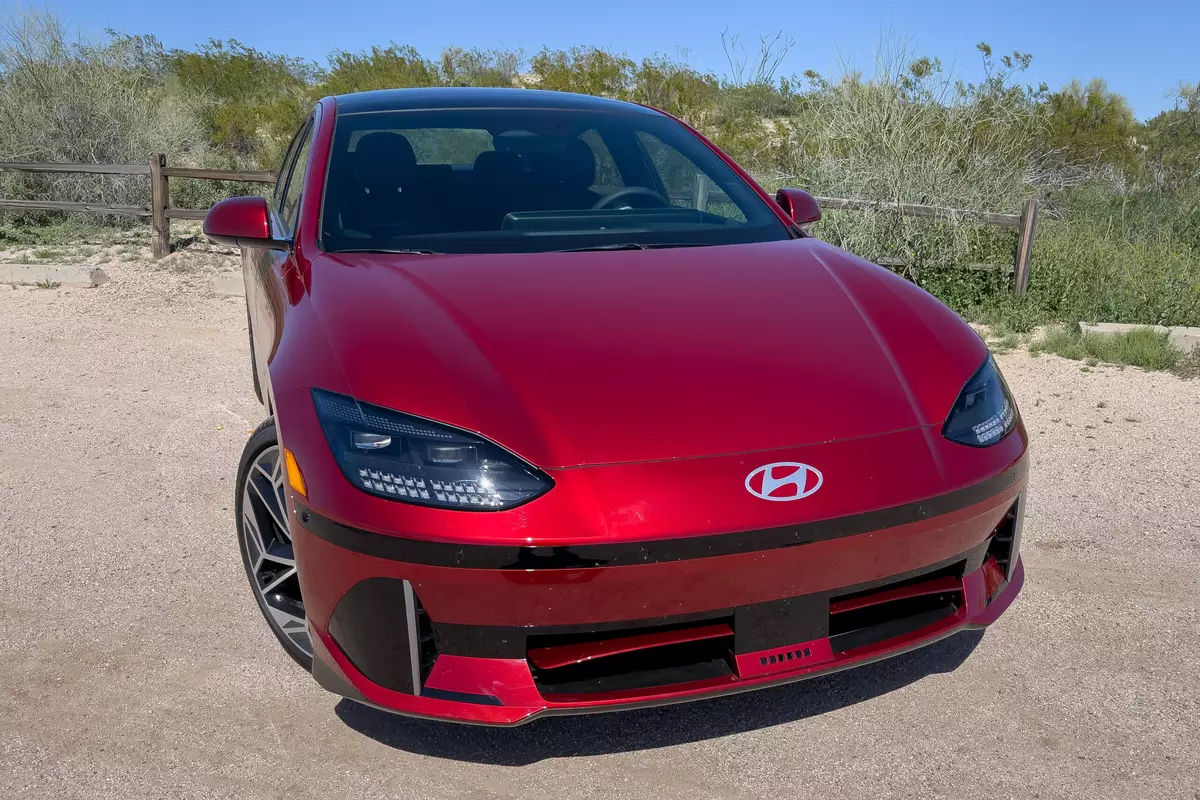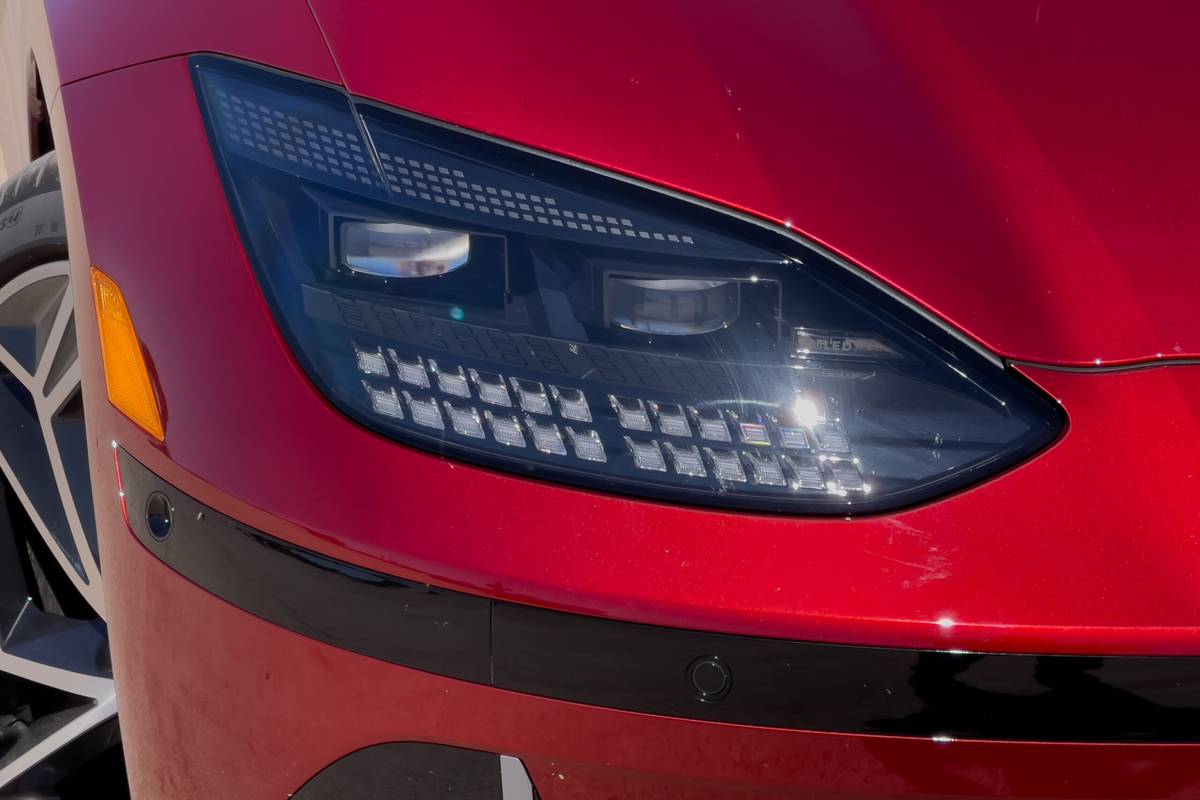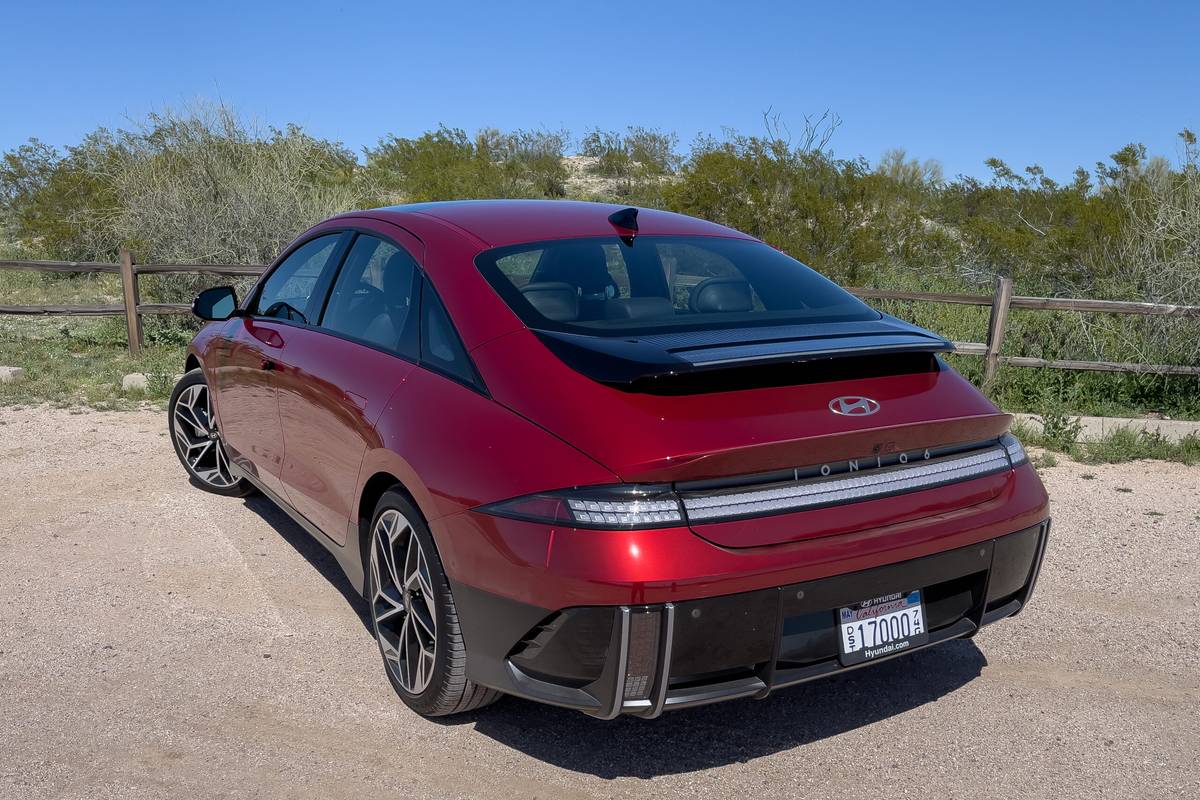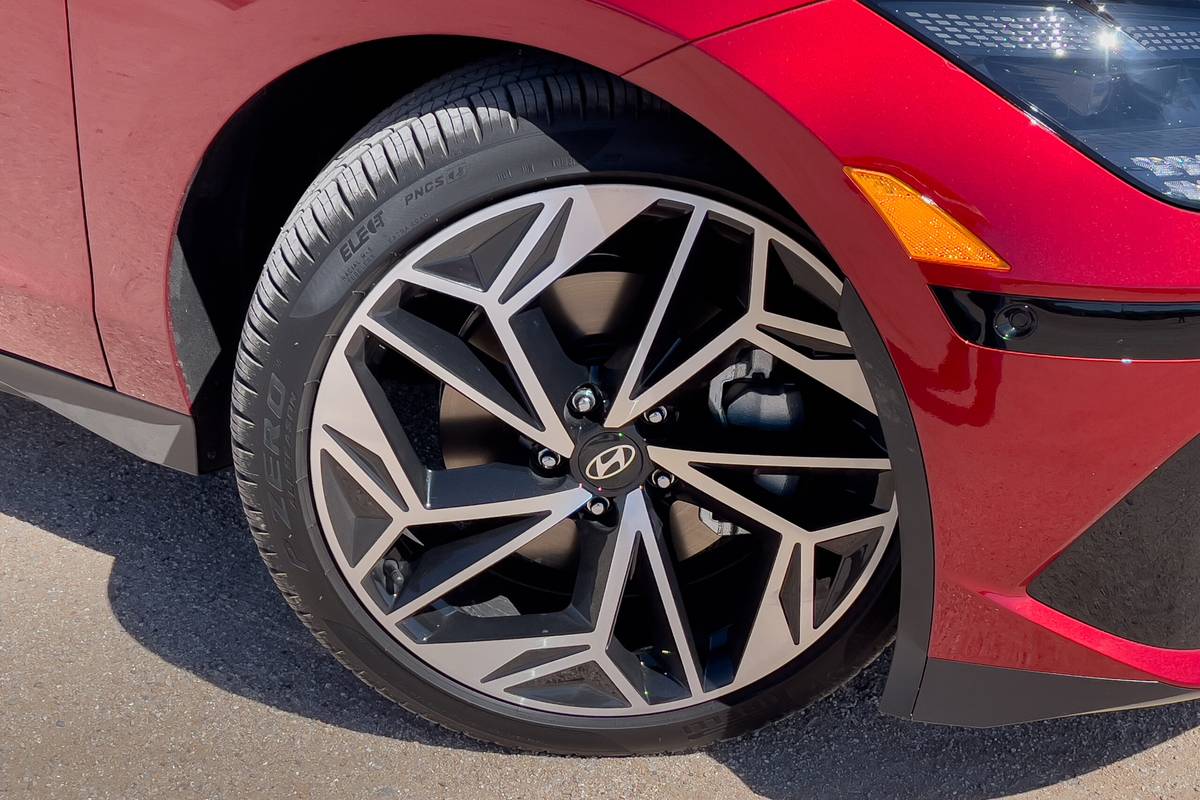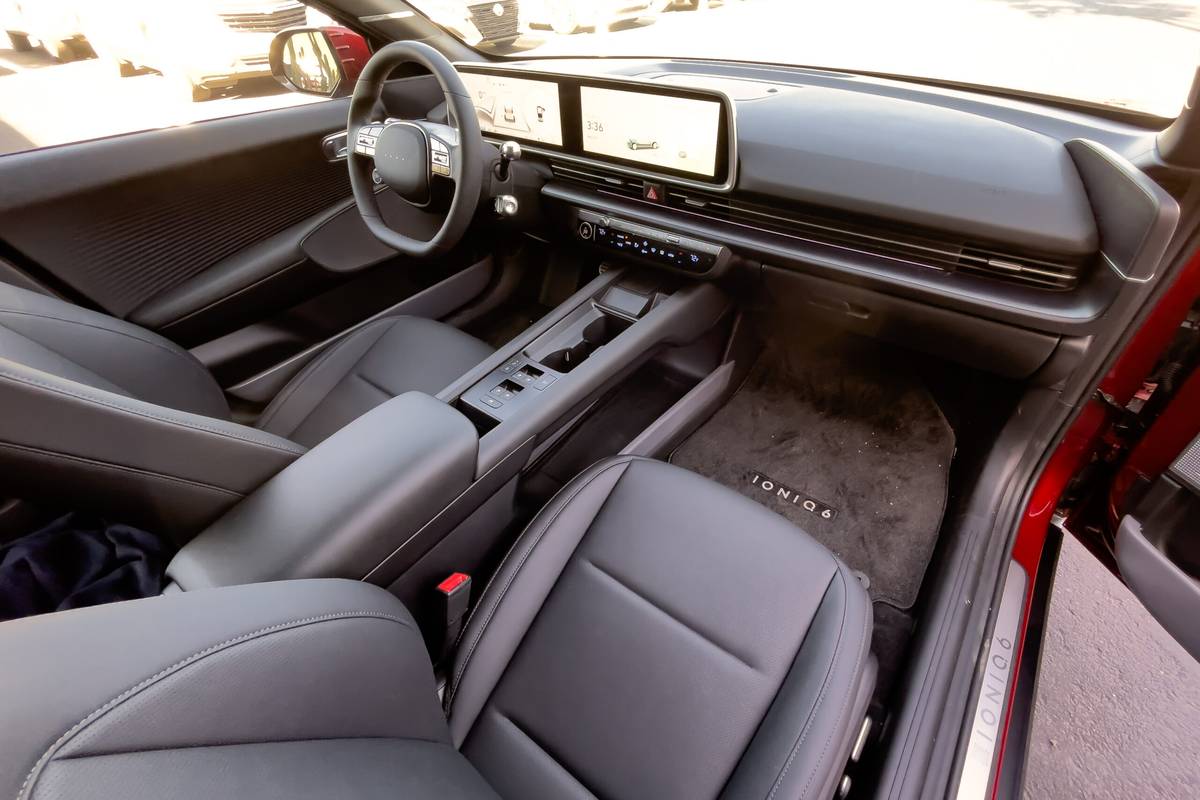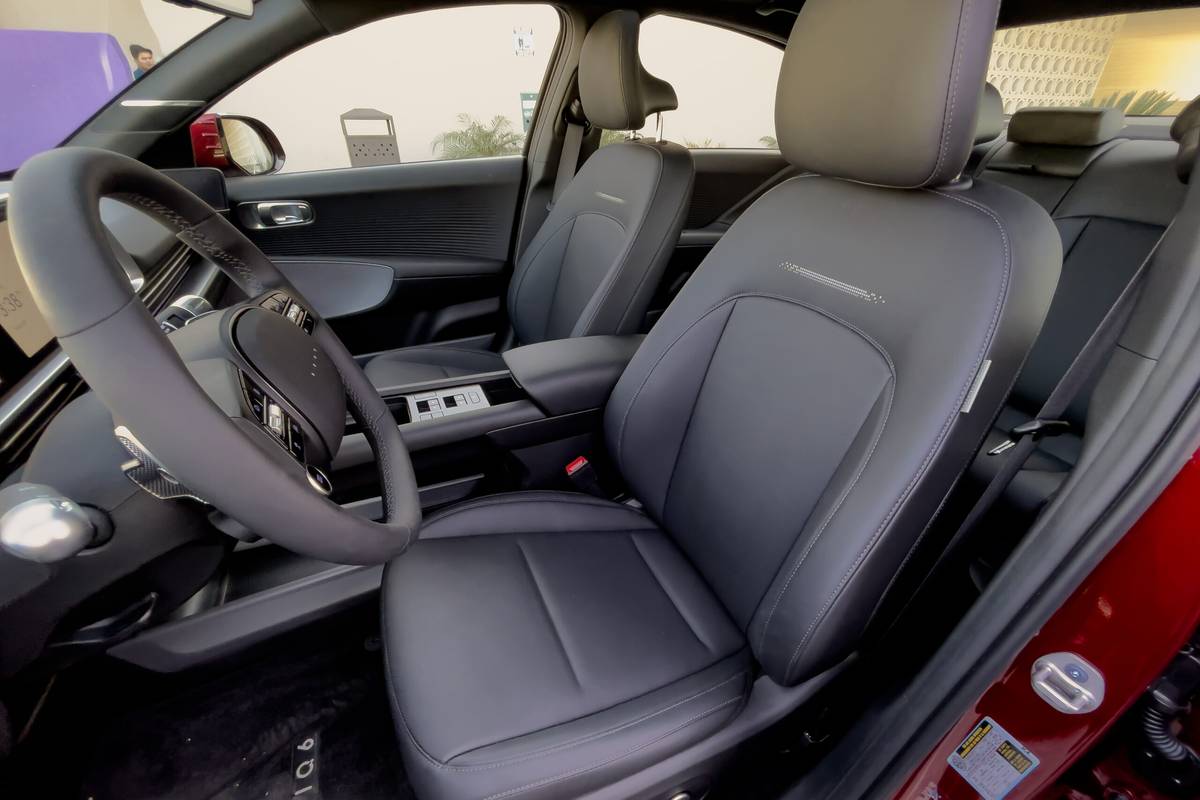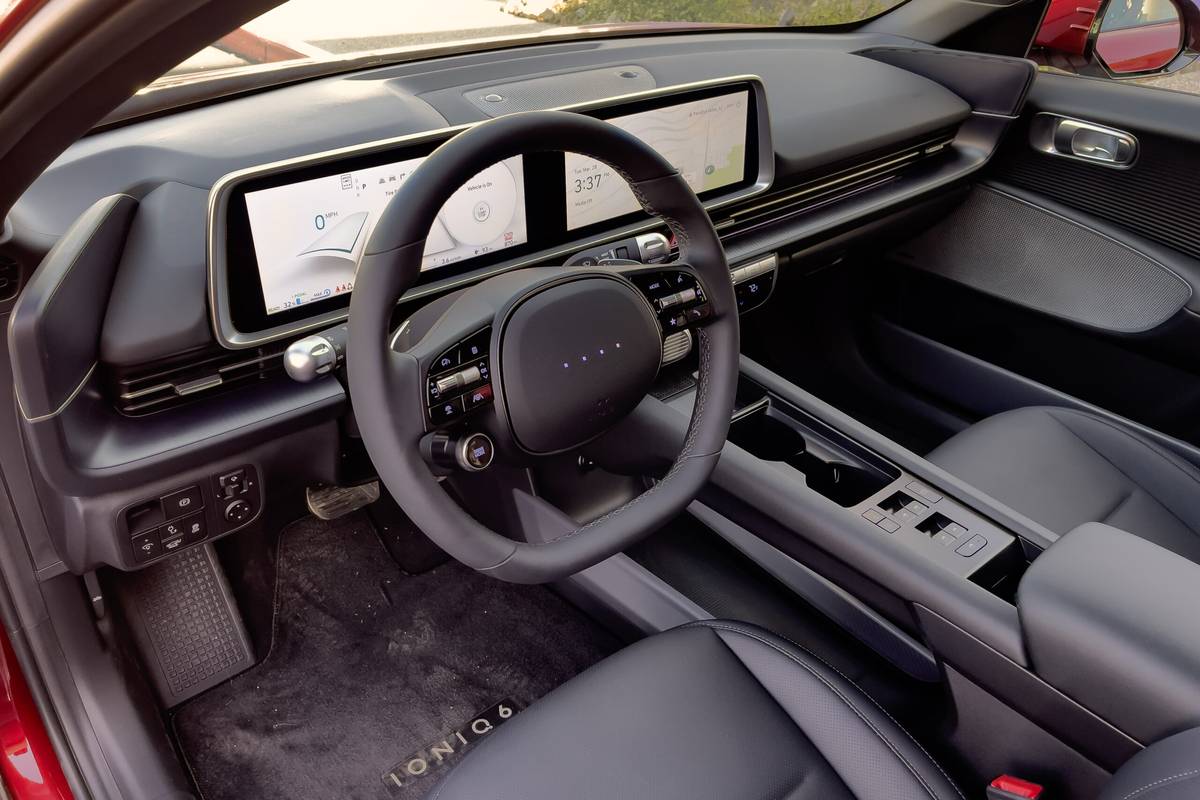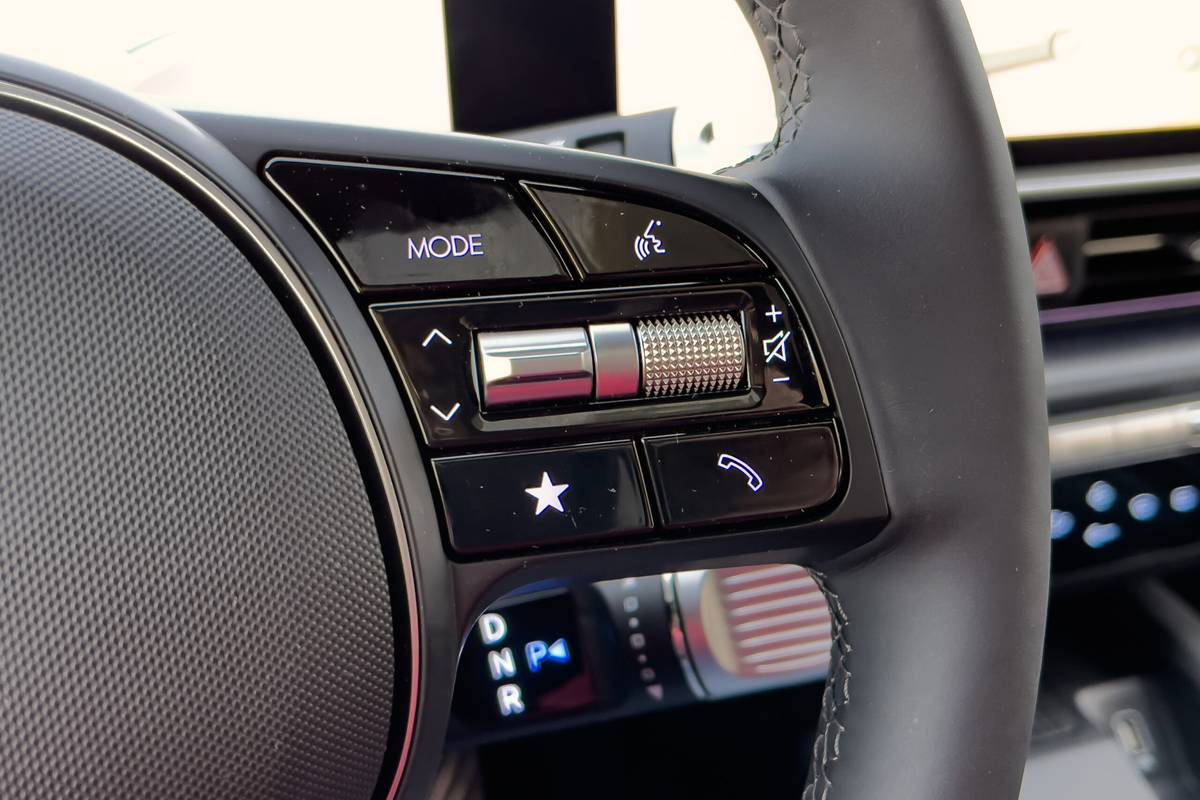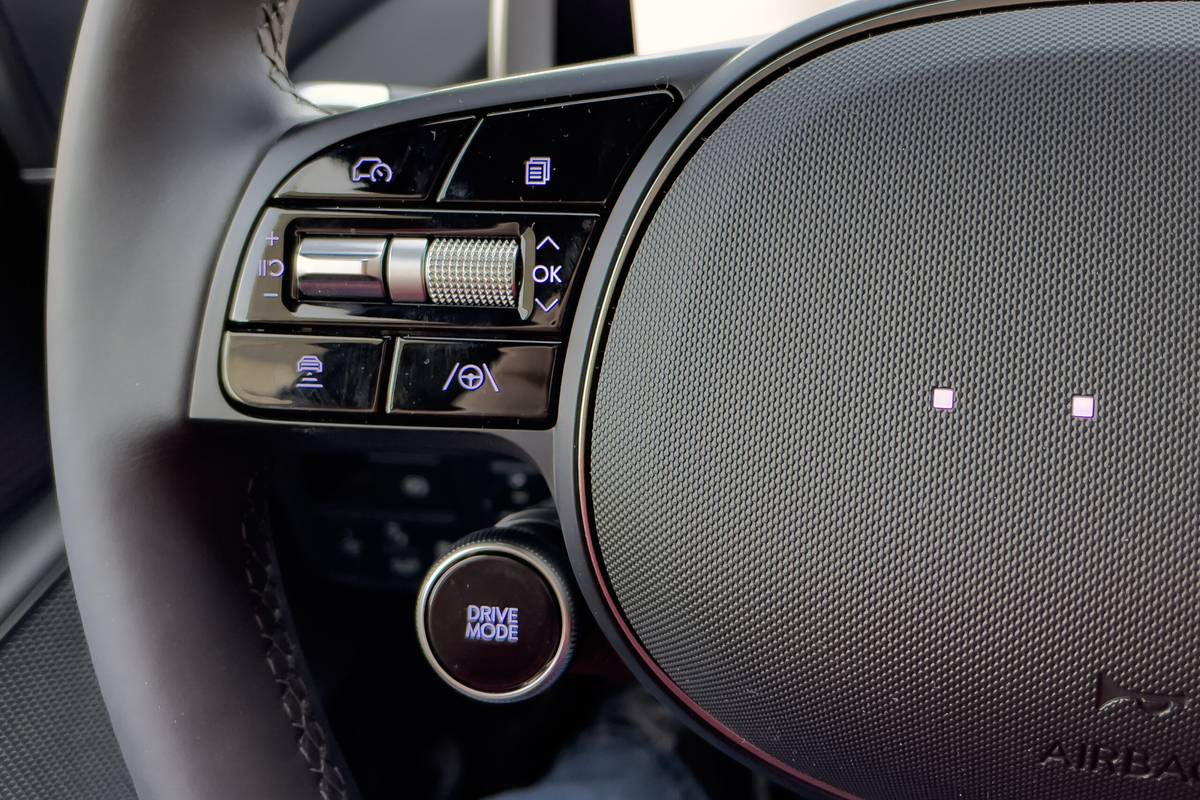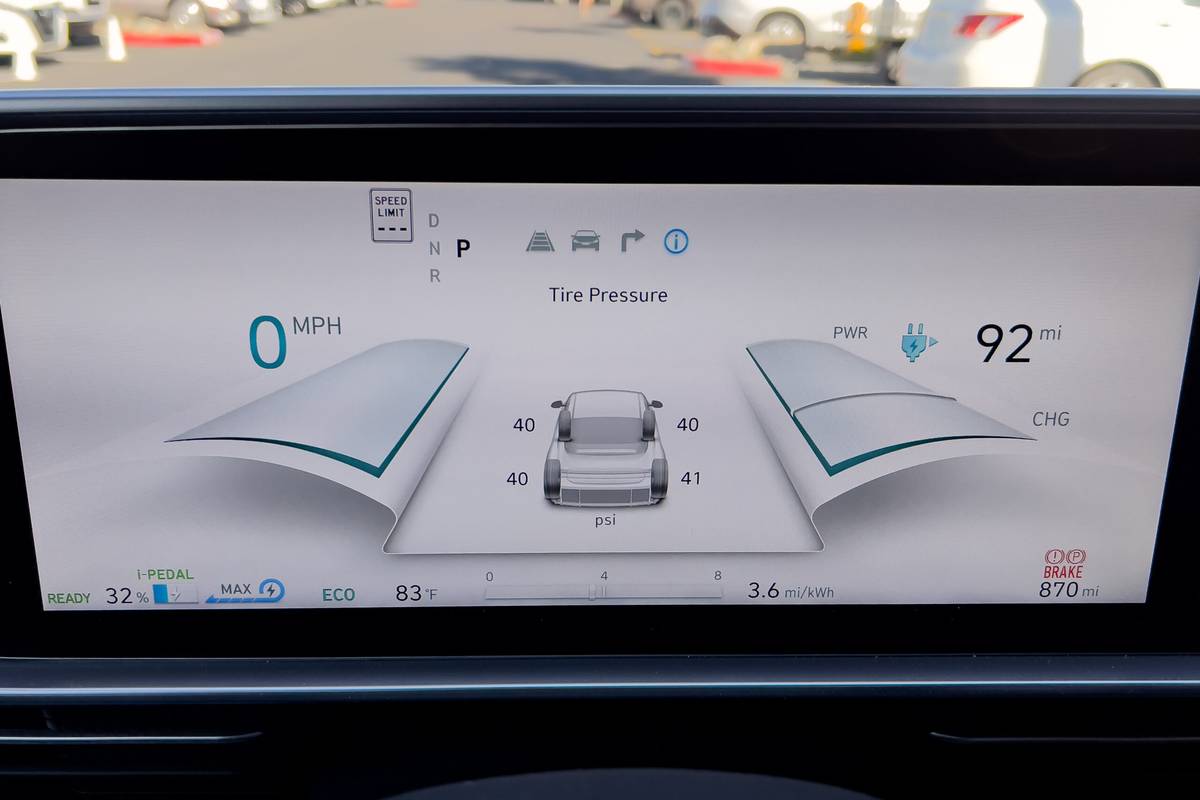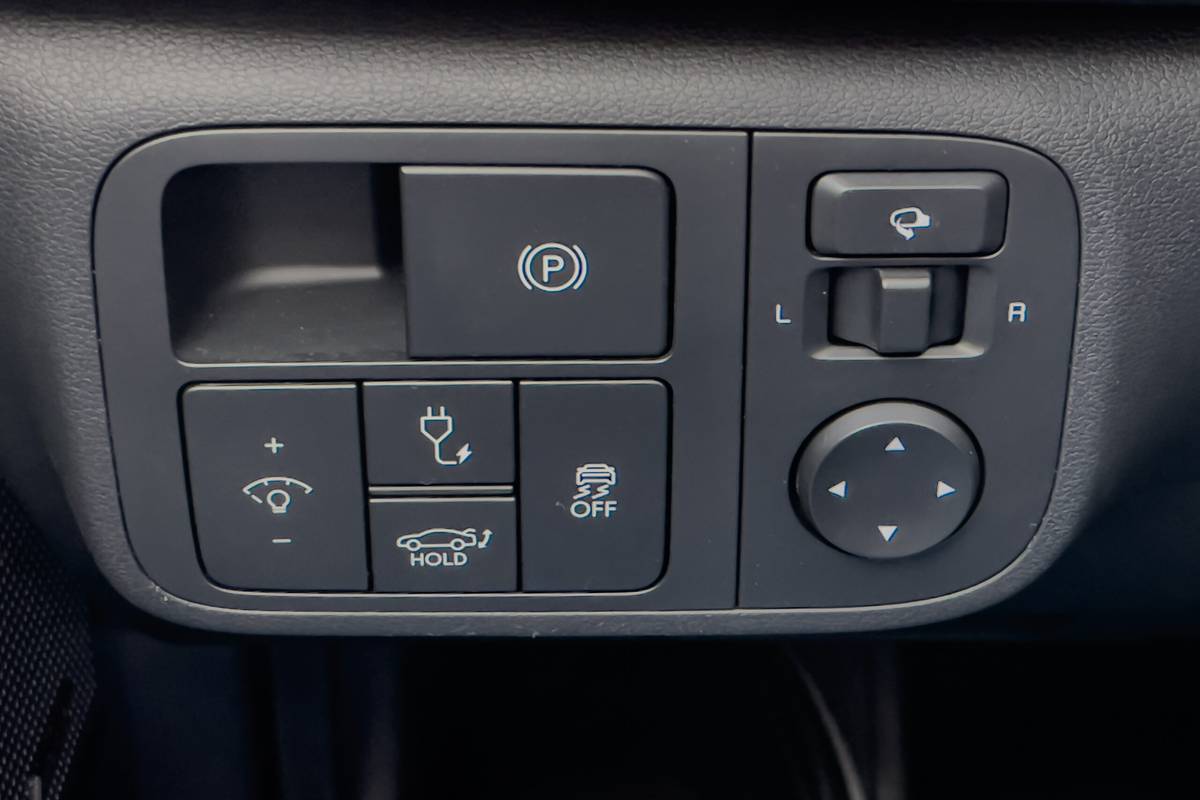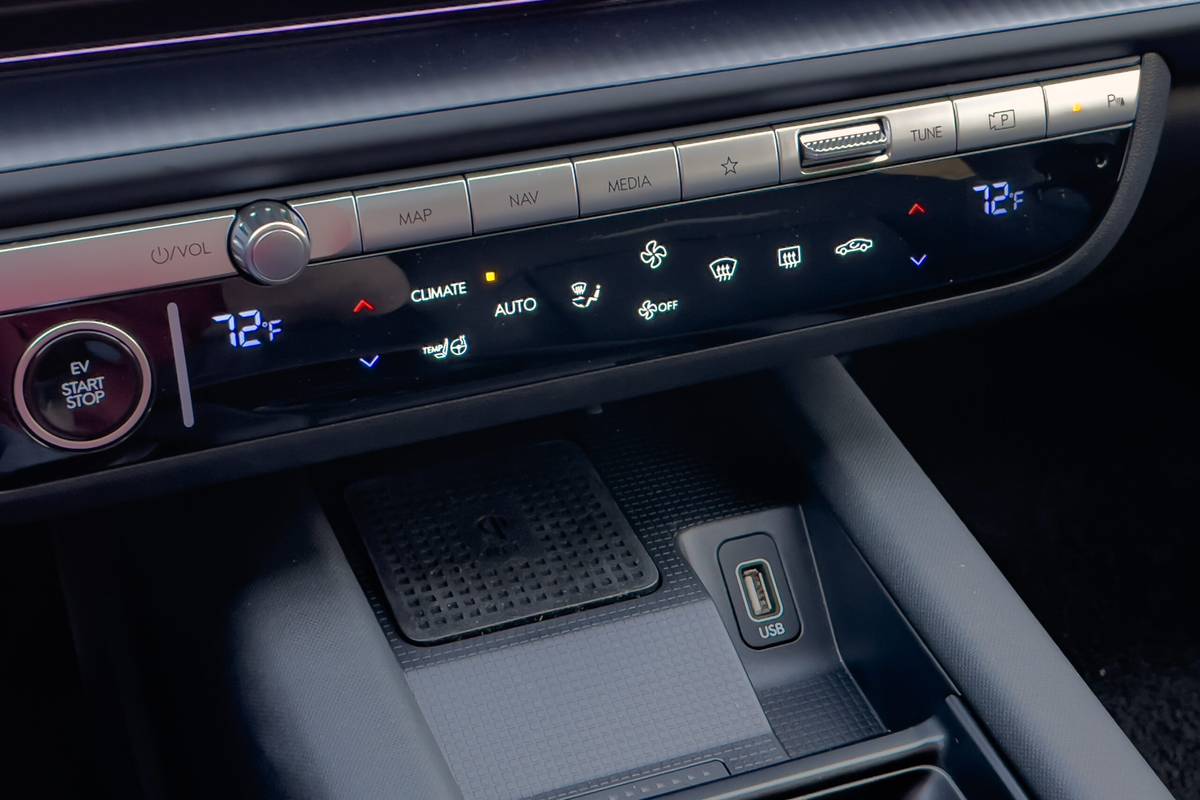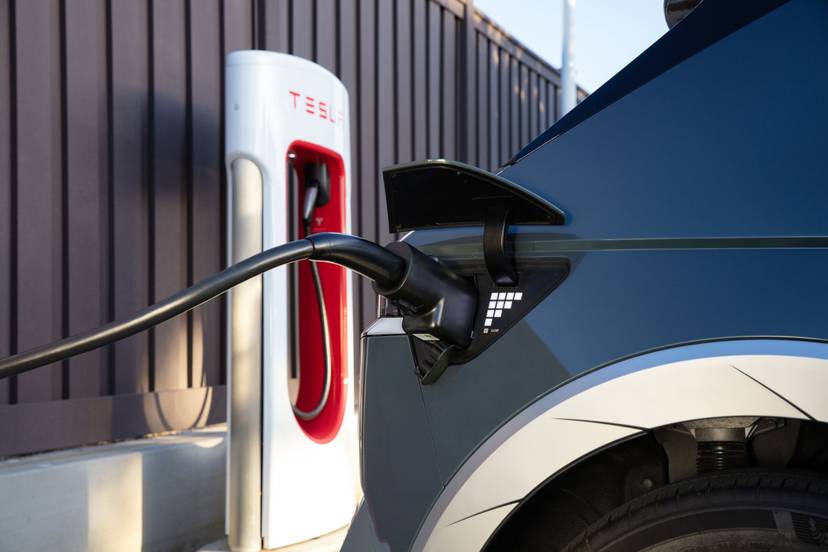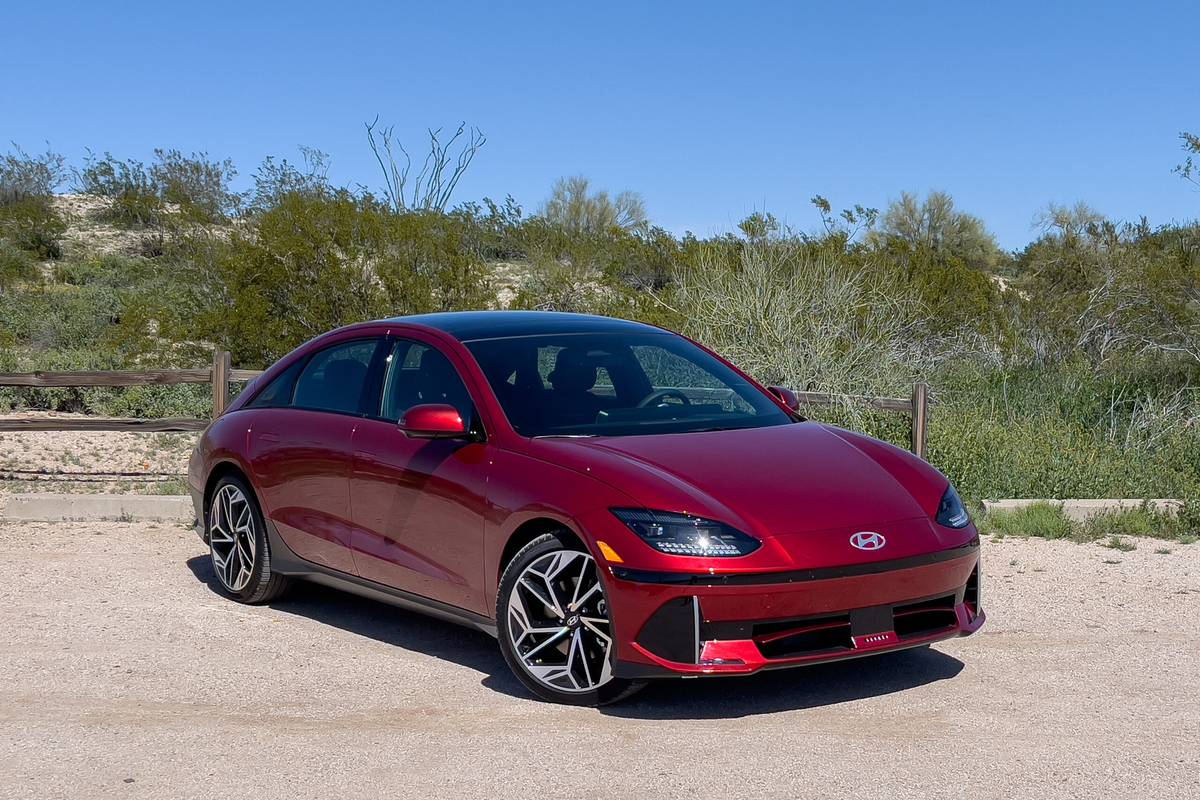
The verdict: Fantastic to look at, outstanding to drive, but only comfortable in the front seats, the all-new 2023 Hyundai Ioniq 6 electric sedan provides an intriguing alternative for the EV SUV-averse.
Versus the competition: Made to go up against the Tesla Model 3 and Polestar 2, the Ioniq 6 is more stylish than both put together and has better onboard tech, good range and quick charging speeds, but its backseat is tight due to that swoopy roofline.
The 2023 Ioniq 6 sedan is the latest all-electric model to grace Hyundai showrooms (available in 44 states, as of publication), and it might just be the weirdest one. But it’s weird in a good way — in a quirky, internationally-globetrotting-aunt way, not in a creepy basement-dwelling-40-something-cousin kind of way.
Related: 2023 Hyundai Ioniq 6 Gets Maximum Range of 361 Miles
What do we mean by that? Well, Hyundai could have just put an ordinary, milquetoast family sedan body over their electric car platform and called it a day, and nobody would’ve looked twice at it. Instead, the company has let its designers go wild and created a flowing modern streamliner that turns heads and gets noticed. And while we applaud the company for taking risks and making something decidedly memorable, that style comes at a price.
Swoop Swoop!
The engineering might make the Ioniq 6 an impressive car, but it’s secondary to the styling of this new five-seat mid-size sedan. It’s the looks of the thing that are all anyone is going to want to talk about when you stop at a rest stop, or park it at work, or run into a gas station for a Slushie and a wee (the only reasons you’ll need to stop at a gas station, of course). It’s simply unlike anything else on the road today, save perhaps a 1993-97 Infiniti J30 at a local Radwood event. It’s also unlike anything else in the Hyundai portfolio, looking nothing like the boxy Ioniq 5 SUV or the angular Seven three-row concept SUV. That’s intentional on Hyundai’s part, as the brand’s designers were given the mandate to design each vehicle more for attracting its intended audience than maintaining similarity with showroom stablemates. You do, however, still have the “Parametric Pixels” theme that’s shared with the Ioniq 5. It runs throughout the car and uses little boxes in everything from the lights of the sedan to some of the interior details.
But aside from that, the Ioniq 6 looks like it could be from a different car company altogether. That slippery shape, inspired by one continuous arc visible in the side profile, actually nets the North American version of the car a 0.22 coefficient of drag when equipped with the 18-inch “aero” wheels and tires. If you opt for the bigger (and better looking) 20-inch wheels, your aero numbers drop a bit, but it’s still incredibly aerodynamic thanks to a flat underbody, special aero tricks for the wheel wells and a spoiler out back that helps keep things planted.
Style With Purpose
Those aero numbers do a few things. They increase the car’s efficiency, allowing it to make the most out of its two available battery packs (a 53-kilowatt-hour one in the standard-range model and a 77.4-kWh one in long-range versions), and they help create a whisper-quiet cabin even at highway speeds. I saw the Ioniq 6 manage 3.6 miles per kWh in my all-day test drive, an impressive number given how aggressively the car was driven. And there’s no wind noise inside, even at 70-plus mph; there’s only tire and road noise, and that can change depending on the quality of the road surface.
That’s one aspect of the Ioniq 6’s interior that impresses; the design, quality, assembly and packaging comprise the rest of it. The interior looks different from the more upright Ioniq 5 SUV, and there isn’t as much space for occupants inside, but the sedan is going after different buyers — young urban couples or singles — than the SUV, which is aimed at families. Style is the priority in this interior, with shapes and materials that are modern and attractive. There’s also an optional dual-color ambient lighting feature that really amps up the “Cyberpunk 2077” vibe at night.
But the interior is also where you pay the penalty for style like this. The floor of the Ioniq 6 is high because that’s where the battery is located, and that makes the seats feel a bit too high even when lowered all the way. The optional moonroof doesn’t help, as it takes away headroom; my head was always touching the headliner.
But it’s the backseat that really pays the price for that swoopy roofline. Anyone over 5-foot-10 is going to have a tough time getting comfortable in the backseat for two reasons: the lack of headroom and the odd lack of toe room. There’s plenty of space between the back of the front seats and backseat passengers, but there’s exactly zero room to be had under those seats for your feet. That space is apparently filled with things for seat ventilation and electronics, so nothing can be slid under them — including backseat passengers’ feet. It makes for a very cramped, knees-up riding experience, and reinforces the fact that the Ioniq 6 is far more about style and front-seat comfort than carrying rear passengers. If one shows up as your summoned Uber, cancel and get something else.
Smooth Driving, Too
Under that shapely body is the same platform that you’ll find under most of Hyundai’s new electric cars, the Electric-Global Modular Platform. That means a rear-wheel-drive single-motor system or an optional all-wheel-drive dual-motor setup. Single-motor RWD cars come with either the standard-range battery and a rather paltry 149 horsepower (you won’t see many of those on the road) or the long-range battery and 225 hp; AWD dual-motor cars all get the long-range battery and make 320 hp. Range varies from a manufacturer-rated 240 miles on the standard range RWD version up to a maximum of 361 estimated miles for the RWD long-range model with 18-inch wheels (EPA figures are not yet official as of this writing). All models have 400/800-volt DC fast-charging ability, enabling the car to go from a 10%-80% charge in as little as 18 minutes if conditions are right, according to Hyundai. They all also have standard navigation systems with EV charger mapping and battery preconditioning, helpful for getting the battery ready for those quick charges.
My test car for a jaunt around the desert highlands north of Scottsdale, Ariz., was a loaded top-spec Limited AWD Long Range with 20-inch wheels, good for 320 hp and 270 miles of range. The meter actually read a bit more than that when I started off, but my purpose in driving wasn’t to see how far it could get on a charge, but instead to evaluate how well the car works; range tests will come later. I can attest that it works very, very well. Hyundai is posing the loaded Ioniq 6 as an alternative to the Tesla Model 3 and Polestar 2, and I think it provides a very compelling alternative to both of those EVs.
Acceleration is brisk, especially in Sport mode — in typical EV fashion, it launches off the line with little aural drama but plenty of speed. Even in Comfort mode, acceleration is plentiful; it never lacks for oomph. The long-range single-motor versions are almost certainly less athletic given their nearly 100-hp deficit, but I was unable to sample those models on this test day. Four levels of increasingly aggressive regenerative braking are available, culminating in true one-pedal driving for those who desire it. And when that’s not enough stopping force, the brakes themselves are firm and communicative.
The Ioniq 6 will hustle through twisties, but it’s still a softer sedan than either the Model 3 or the Polestar 2. It holds its own on canyon roads, but it doesn’t have the sports-car sharpness of the Tesla or the body control of the Polestar. That’s not to say it’s bad, as it’s not at all — the Ioniq 6’s handling is neutral and well balanced, but steering reactions are a bit slow, and you do feel a lot of weight transfer as you flog it down a winding road. Driven with moderate speed, it’s plenty entertaining and solid, with nicely weighted, direct steering but a fair bit of body roll.
It makes up for that handling softness with ride quality that’s outstanding; it’s far better than the stiffly sprung Tesla, and smoother than the Polestar’s thanks to the Hyundai’s longer wheelbase. What the Ioniq 6 does leave room for is a sharper high-performance version, which Hyundai is expected to produce as the Ioniq 6 N, a version of which has already been shown as the stunning RN22e concept.
All the Tech
One area that Hyundai still excels at is usable, stylishly presented technology. The displays in the Ioniq 6 are going to be familiar to anyone who’s been in a newer Hyundai, with the 12.3-inch dashboard touchscreen front and center and another digital display behind the steering wheel. Both use familiar graphics and have plenty of reconfigurability and customization options, and are quick and easy to use on the go. The climate controls are in a fairly low touchscreen strip, something we’re not generally a fan of, but they work well enough here.
Some other controls are a bit surprising, like the single bank of window switches and door lock buttons all on the center console — made possible by the gear selector being a steering-column-mounted rotating stalk, just like in the Ioniq 5. It means there are no lock or window switches on the doors, which might be cheaper to manufacture but are still a bit quirky. There’s also surprisingly no head-up display, something that’s fairly common in cars at this price point regardless of powertrain type and a feature that the Ioniq 5 offers, and Hyundai still has not managed to integrate wireless Apple CarPlay and Android Auto into its 12.3-inch touchscreen system (both connectivity methods are wired-only). But my loaded Limited test model did have everything else you could want, such as heated and ventilated front seats, rear climate vents and all sorts of advanced safety systems. There’s even an available adapter you can plug into the charge port that has a household outlet on it, enabling vehicle-to-load capability so you can power external electrical items using the car’s battery.
More From Cars.com:
- Up Close With the 2023 Hyundai Ioniq 6: The Latest Ioniq Swoops In
- Best Electric Vehicle of 2023
- 2023 Hyundai Ioniq 5 Gets More Range, Equipment, $1,500 Price Increase
- What to Know Before Purchasing an Electric Vehicle: A Buying Guide
- Shop for a 2023 Hyundai Ioniq 6
Competitively Priced, But No Tax Breaks
Not many people really seem to want sedans these days (the Ioniq 6 is a proper sedan, too, not a hatchback), which makes introducing one like this a bit of a head scratcher. But there are some people who just do not want an SUV, and for them, the Ioniq 6 might make some sense. It’s priced competitively, starting at $42,715 for the SE Standard Range with RWD (all prices include $1,115 destination), but I don’t expect many of these to be produced. Next is the SE Long Range with RWD for $46,615 or the AWD version for $50,115. The mid-level SEL starts at $48,815 with RWD and the long-range battery or $52,315 with AWD. The top trim is the Limited, which comes in RWD long-range form for $53,715 or $57,215 with AWD.
A problem for the Ioniq 6 is that, as of publication, it doesn’t qualify for any federal tax incentives to bring its price down (unless you somehow snag a commercial lease on one). This puts it at something of a disadvantage in relation to the Model 3, which currently starts at $44,380 — but then, Hyundai isn’t likely to change the price of the Ioniq 6 on a whim several times a year like Tesla has shown a willingness to do with its models. This means Ioniq 6 resale value should be more stable, and you’re unlikely to wake up one day to find that you’re suddenly underwater on your car loan due to a big drop in new-vehicle pricing.
The Ioniq 6 presents an intriguing alternative to both the Model 3 and the Polestar 2. It’s more stylish than both of them put together, has a far nicer and better equipped interior than either of them, feels nearly as quick, is as enjoyable to drive and simply looks like a more attractive package overall. It does have a deficit in the backseat department, however, so if carrying passengers is a regular occurrence, the Tesla still might be a better idea. In just about every other situation, however, an Ioniq 6 might be a great step up.
Related Video:
Cars.com’s Editorial department is your source for automotive news and reviews. In line with Cars.com’s long-standing ethics policy, editors and reviewers don’t accept gifts or free trips from automakers. The Editorial department is independent of Cars.com’s advertising, sales and sponsored content departments.
































